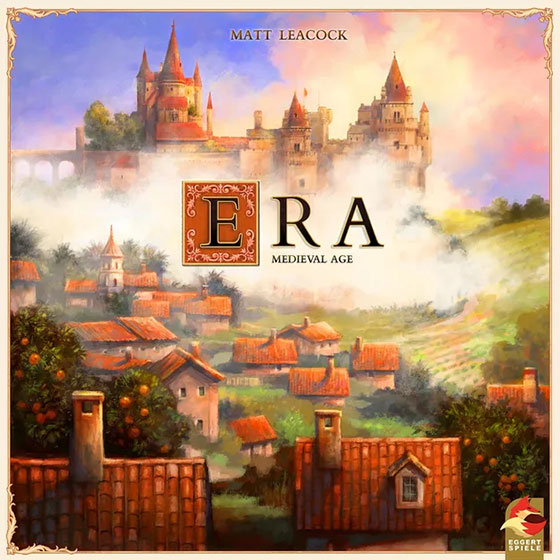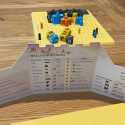‘Era: Medieval Age’ Board Game Review

I don’t think I would be exaggerating if I said that Roll and Write games had become the hottest genre in board gaming during late 2019 and onwards into 2020. This phenomenon had a lot to do with accessibility, both in terms of gameplay and price point, but what would happen if you took the inexpensive paper model of a Roll and Write and replaced it with the expense of highly customised plastic miniatures? Well, that’s exactly what designer Matt Leacock and artist Chris Quilliams did when they created Era: Medieval Age.
Yes, there are certainly other Roll and Build games out there, but none that I have played come with quite the same level of plastic pageantry as Era: Medieval Age. This game comes in a sizeable box which, in addition to room for the already released expansion, contains a large amount of plastic buildings, a ton of very high-quality dice, and relatively little else. There are four small cardboard screens to shield player choices and each player has a personal “peg board” which is also made of plastic, but other than that, that’s all there is to Era: Medieval Age.
In Era: Medieval Age players will set out to build the best possible city – which is represented by the peg board I mentioned earlier. Each city begins with a fort, several pieces of wall, a farm and three longhouses. Depending on player count, the players may also need to place some wasteland pieces, which effectively just take up space and make the board smaller. Players will also be given a set amount of stone, wood and food to start the game with, as well as three yellow dice (to match the longhouses) and a grey dice (to match the fort.
Just by inferring that the fort and longhouse pieces are linked to dice, you’re probably already imaging part of how Era: Medieval Age plays out. This is a game about rolling dice – which in turn generate resources (and disasters, which I’ll come to later) that can, in turn, be spent on more buildings which often add to your dice pool, or modify your dice rolls. Among the resources you roll for, food is used to pay for dice, wood and stone is used to build, and trade goods are primarily linked to end game points, but may also be used in other ways.
Your basic starting (yellow longhouse) dice will show food, wood, stone and hammer symbols, whilst your grey fort die will show swords and shields. On some die faces, you’ll also see one or two skulls – denoting disasters. Players are free to roll their dice up to three times (in secret behind their screens) before declaring them, but any face showing a skull must not be rerolled. Clearly, there is an element of trust here, but as Tom Wasel always says, why would you be playing casual board games with people you don’t trust anyway?
Only once everyone has rolled their dice will the screens be removed and dice compared. This is because those sword and shield die-faces I mentioned earlier can be used to extort resources from other players, whilst in addition, rolling three skulls or five will have an adverse effect on your opponents (whilst one, two, four or six skulls will have an adverse effect on you.) This secretive, cunning interaction is a fairly minor part of the game in terms of time and engagement between players, but the impacts can be quite big – losing a building, for example, really hurts.
After a few turns, and certainly after several games, play in Era: Medieval Age becomes second nature. The turn structure is simple – roll dice simultaneously, declare that everyone is ready, then take the benefits as shown on dice (affecting tracks, primarily.) Feeding your dice happens next, but familiar players will just adjust their income and feeding debt at the same time – for example if you generate five food and owe six, you’ll just move your food track down one. Note that some buildings (like your starting farm) will generate a resource without a die needing to be rolled.
After this, disasters are calculated. To do this, each player simply looks at the number of skulls they have rolled and acts accordingly. One skull will force a player to either lose a resource or advance one space on their disaster track (which will score negative victory points at the end of the game.) Two skulls asks the player to look at their board and advance on the disaster track for every clustered (adjacent) building. Three skulls, as I mentioned earlier, damages each opponent by asking them to place a wasteland tile onto their boards. Four, five and six skull rolls all have increasingly dire effects. One criticism of Era: Medieval Age is that skulls and the disaster track are not – in my opinion – very well explained, and I have had to use FAQ’s to conclude a final position on how to resolve them as described above.
Next, you’ll all build – beginning with the first player. Turn order is really important here for several reasons; firstly because buildings are limited in number, secondly because each player does all the builds they can at once (based on how many hammers they rolled) and finally because depending on player count, the game end will be triggered when a set number of building pools have been depleted. Each build is simple to perform – the active player simply reduces their resource track accordingly, then takes the building miniature and places it onto their board.
Finally, the players will extort. This is done based on how many shields and swords have been rolled, which the player who has most swords extorting every other player (except one that has an equal or greater number of shields) and each other player who has fewer swords (but more than at least one other player) extorting only those with fewer swords (again, excepting anyone who has shields.) So in effect, this is a mechanic for a player who has a lot of military might to take goods from their neighbour, whilst shields come in to play because they are not generated exclusively by militaristic buildings (making a defensive/build focussed hybrid strategy viable.)
Once the required number of building piles is exhausted, the game end will trigger and players calculate their points. This is done by adding up the values of each building plus any unique scoring aspects – such as collected culture, how many trade goods you have etc. Any building that is completely surrounded by walls will also be worth double, so a simple decision in every game is whether to go for a “big” city without walls, or a smaller, completely walled city. Every building has strengths and weaknesses and playing with different strategies for how to set up your city is the key area of interest in Era: Medieval Age.
Overall then, this is a very simple, extremely quick and very attractive game that isn’t actually too expensive given the amount of plastic you’ll find in the box. It’s probably just above gateway level because of some of the complexities of resolving disasters and extortion, but any moderately experienced gamer should have no trouble picking up Era: Medieval Age and would likely be able to teach it to a complete novice. Whilst it is, in essence, not much more complex than any Roll and Write, the physical aspect really adds something, and as a result Era: Medieval Age is currently sitting pretty on my “keep” shelf.

















































